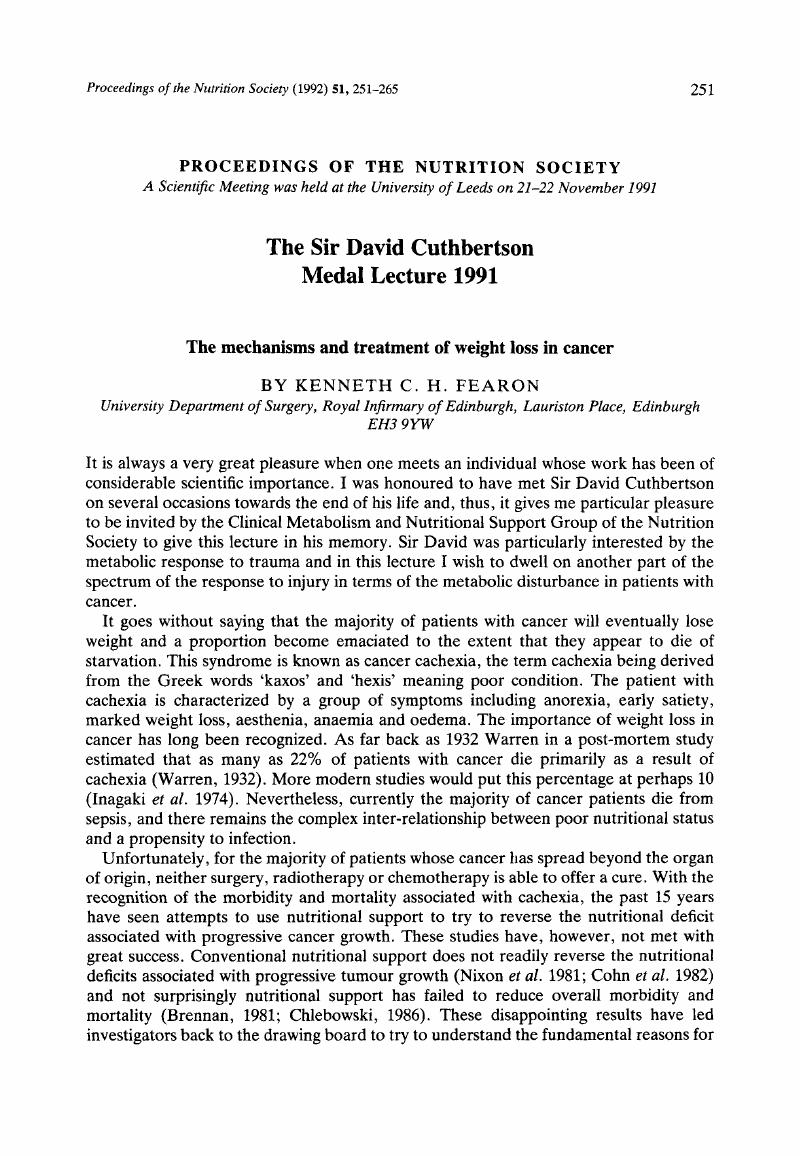Crossref Citations
This article has been cited by the following publications. This list is generated based on data provided by Crossref.
Preston, T
Fearon, K C H
McMillan, D C
Winstanley, F P
Slater, C
Shenkin, A
and
Carter, D C
1995.
Effect of ibuprofen on the acute-phase response and protein metabolism in patients with cancer and weight loss.
Journal of British Surgery,
Vol. 82,
Issue. 2,
p.
229.
Nomura, Katsutoshi
Noguchi, Yoshikazu
and
Matsumoto, Akihiko
1996.
Stimulation of decreased lipoprotein lipase activity in the tumor-bearing state by the antihyperlipidemic drug bezafibrate.
Surgery Today,
Vol. 26,
Issue. 2,
p.
89.
van Binsbergen, JJ
1997.
Nutritional factors in Dutch family medicine: an inventory.
The American Journal of Clinical Nutrition,
Vol. 65,
Issue. 6,
p.
1967S.
De Blaauw, Ivo
Eggermont, Alexander M.M.
Deutz, Nicolaas E.P.
De Vries, Marc
Buurman, Wim A.
and
Von Meyenfeldt, Maarten F.
1997.
TNF-α has no direct in vivo metabolic effect on human muscle.
International Journal of Cancer,
Vol. 71,
Issue. 2,
p.
148.
Grimble, Robert F.
1998.
Fasting in healthy individuals and adaption to undernutrition during chronic disease.
Current Opinion in Clinical Nutrition and Metabolic Care,
Vol. 1,
Issue. 4,
p.
369.
Preston, Tom
Slater, Christine
McMillan, Donald C.
Falconer, J. Stuart
Shenkin, Alan
and
Fearon, Kenneth C.H.
1998.
Fibrinogen Synthesis Is Elevated in Fasting Cancer Patients with an Acute Phase Response.
The Journal of Nutrition,
Vol. 128,
Issue. 8,
p.
1355.
Davidson, H. I. M.
Pattison, R. M.
and
Richardson, R. A.
1998.
Clinical undernutrition states and their influence on taste.
Proceedings of the Nutrition Society,
Vol. 57,
Issue. 4,
p.
633.
Fearon, Kenneth C. H.
Falconer, J. Stuart
Slater, Christine
McMillan, Donald C.
Ross, James A.
and
Preston, Tom
1998.
Albumin Synthesis Rates Are Not Decreased in Hypoalbuminemic Cachectic Cancer Patients With an Ongoing Acute-Phase Protein Response.
Annals of Surgery,
Vol. 227,
Issue. 2,
p.
249.
Todorov, P T
Field, W N
and
Tisdale, M J
1999.
Role of a proteolysis-inducing factor (PIF) in cachexia induced by a human melanoma (G361).
British Journal of Cancer,
Vol. 80,
Issue. 11,
p.
1734.
Barber, Matthew D.
Ross, James A.
and
Fearon, Kenneth C.H.
1999.
Cancer cachexia.
Surgical Oncology,
Vol. 8,
Issue. 3,
p.
133.
Barber, Matthew D.
Ross, James A.
and
Fearon, Kenneth C. H.
1999.
Changes in Nutritional, Functional, and Inflammatory Markers in Advanced Pancreatic Cancer.
Nutrition and Cancer,
Vol. 35,
Issue. 2,
p.
106.
Fearon, Kenneth C.H.
Barber, Matthew D.
and
Moses, Alastair G.W.
2001.
The Cancer Cachexia Syndrome.
Surgical Oncology Clinics of North America,
Vol. 10,
Issue. 1,
p.
109.
Barber, Matthew D.
2001.
Cancer cachexia and its treatment with fish-oil-enriched nutritional supplementation.
Nutrition,
Vol. 17,
Issue. 9,
p.
751.
Tisdale, Michael John
2001.
Facteurs lipolytiques et protéolytiques de la cachexie cancéreuse.
Nutrition Clinique et Métabolisme,
Vol. 15,
Issue. 4,
p.
266.
Tisdale, Michael J
2001.
Cancer anorexia and cachexia.
Nutrition,
Vol. 17,
Issue. 5,
p.
438.
Fearon, Kenneth C.H
and
Moses, Alastair G.W
2002.
Cancer cachexia.
International Journal of Cardiology,
Vol. 85,
Issue. 1,
p.
73.
Russell, S T
Hirai, K
and
Tisdale, M J
2002.
Role of β3-adrenergic receptors in the action of a tumour lipid mobilizing factor.
British Journal of Cancer,
Vol. 86,
Issue. 3,
p.
424.
Russell, S T
and
Tisdale, M J
2002.
Effect of a tumour-derived lipid-mobilising factor on glucose and lipid metabolism in vivo.
British Journal of Cancer,
Vol. 87,
Issue. 5,
p.
580.
Tisdale, Michael J.
2002.
Cachexia in cancer patients.
Nature Reviews Cancer,
Vol. 2,
Issue. 11,
p.
862.
Gomes-Marcondes, M C C
Smith, H J
Cooper, J C
and
Tisdale, M J
2002.
Development of an in-vitro model system to investigate the mechanism of muscle protein catabolism induced by proteolysis-inducing factor.
British Journal of Cancer,
Vol. 86,
Issue. 10,
p.
1628.



